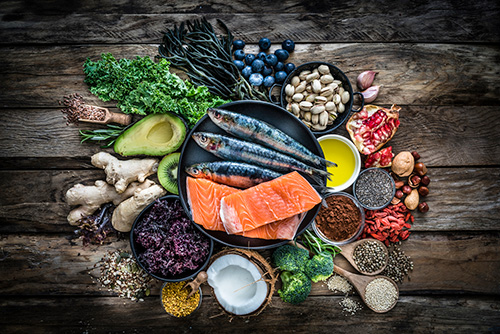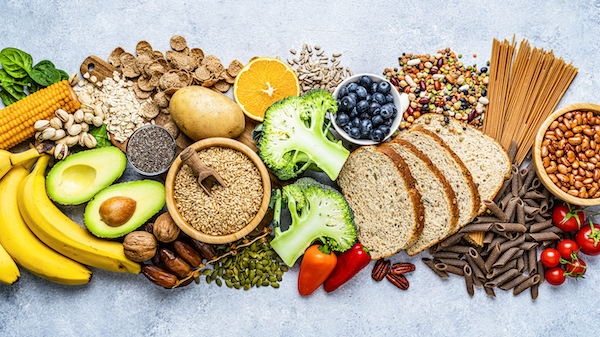Over 20 years ago, many of you may recall hearing a lot about the health benefits of omega-6s in the American diet. Nowadays, you might be wondering why everyone’s trumpeting omega-3s. Then there’s the Mediterranean diet, which has stood the test of time, but the heart of the diet — olive oil — is richest in omega-9s! Let’s face it, the numbers are confusing. But which fatty acid is best for a healthy body? And what’s the difference between them?

In a nutshell, the difference between one fatty acid and another comes down to tiny molecules. Slight differences in molecular configuration allow each of these fatty acids to work wonders in their own unique ways, which is why it’s best not to think about one being better than another — instead, let’s go into more detail why a good balance of all three is so favorable to your health.
Fatty acids and their numbers
All fat is made up of fatty acids, and all fatty acids are composed of chains of carbon (C), hydrogen (H) and oxygen (O) atoms. When we get down to the molecular level, we see that fatty acids have long, fatty tails that bend about in different directions. Some are straight as an arrow, with no double bonds — these are the saturated fatty acids. The other group has varying numbers of double bonds that make them bend to varying degrees — some even touching their toes. These include the unsaturated fats, also referred to as monounsaturated fats (MUFAs), which have one double bond; and the polyunsaturated fats (PUFAs), meaning there’s more than one double bond.
Fatty acid names and numbers also correspond to the number of C atoms they contain, and designate where and how they bond and twist together with H and O atoms. Omega-3, 6 and 9, for example, are all unsaturated fatty acids with double bonds in the 3, 6, or 9 positions, respectively.
This matters because the configuration of a fat molecule’s single and double bonds has major implications for its properties and effects in our bodies — for better or worse! A closer look at the three big omegas should help clarify some of these implications.
The difference between omega-3s, 6s and 9s — parents and offspring
omega-3s
Omega-3 fatty acids are extremely important for our health — probably the most important of the three. One major reason for this is because they tend to suppress inflammation, which is the cause of so many of the degenerative diseases that plague us. They do this by countering the pro-inflammatory effects of omega-6s, which we’ll talk about next.
| Table of major fatty acids | ||
|---|---|---|
| Omega-3 fatty acids polyunsaturated (PUFAs) |
Omega-6 fatty acids polyunsaturated (PUFAs) |
Omega-9 fatty acids monounsaturated (MUFAs) |
| Alpha linolenic acid (ALA, or more commonly LNA) — essential | Linoleic acid (LA) — essential | Oleic acid |
| Eicosapentaenoic acid (EPA) | Gamma-linolenic acid (GLA) | Mead acid |
| Docosahexaenoic acid (DHA) | Arachidonic acid (AA) | Erucic acid |
Our bodies cannot make the “parent” molecule for omega-3 fatty acids, alpha linoleic acid (ALA – in blue in table to right), on its own. Therefore, this omega-3 — ALA — is considered an “essential” fatty acid. Downstream, the parent ALA gets metabolized into the two most beneficial fatty acids: eicosapentaenoic acid (EPA) and docosahexaenoic acid (DHA). It would be difficult to oversing the praises of EPA and DHA, which have powerful anti-inflammatory effects, along with playing a range of other crucial roles in the body.
Because the parent ALA is not manufactured by our bodies, and because it isn’t all that readily converted to its “offspring” EPA and DHA either, it’s critical that we get these fatty acids through our diets. What complicates the matter is that these omega-3s are the ones most lacking in our modern diet. Nonetheless, they can be consumed in foods such as wild-caught salmon, mackerel, anchovies, walnuts, flaxseed and green leafy vegetables — we just have to remember to include these foods in our daily choices. In addition, they can more readily be obtained through high-quality omega-3 supplements.
(See the benefits of omega-3s for more about why women of all ages need ample EPA and DHA, as well as a list of foods rich in o-3s and tips on choosing the best omega-3 supplement.)
Omega-6s
As in the family of omega-3s, there’s one member of the omega-6 family that plays the role of the parent (essential) fatty acid: linoleic acid (LA – in blue in table above). What’s different about LA is that it is not as difficult to find in our typical American diet as ALA. In reality, most of us get too much omega-6s in our popular foods. Omega-6s can be found abundantly in many of our common vegetable cooking oils: soybean oil, sunflower oil, canola oil and corn oil (but not olive oil). They’re also common ingredients in many of the foods we consume, which is why most of us have a heavily imbalanced ratio of omega-6s to 3s.
The ratio of 6s to 3s is an important consideration for your health because LA tends to gear up the inflammatory process. If you’ve read our article on the ups and downs of inflammation, you know how crucial the inflammatory process is to survival, but also how it requires — as do all cycles in living systems — an efficient set of checks and balances. Without effective and timely up-regulation and down-regulation through a balance between o-6s and o-3s, inflammation can become chronic and problematic, leading to heart disease, diabetes, and Alzheimer’s — to name a few.
Omega-9s
Omega-9s are the most abundant fatty acids of all in nature, and they are not in short supply in our diets. They are also not considered essential because our bodies can make omega-9s from unsaturated fat in our bodies. Omega-9 fatty acids can be used by the body as a substitute for omega-3s or 6s if these essential fats are not present. However, omega-9s really aren’t an ideal replacement for 3s and 6s, and the body will eventually suffer from this.
Omega-9s are found in animal fats and vegetable oils, most notably olive oil. Interestingly, the oil made by our skin glands is the same omega-9 fatty acid found abundantly in olive oil: oleic acid. Olive oil also contains a saturated fatty acid known as palmitic acid, but no 6s or 3s. We have stacks of data on the wondrous disease-prevention powers of olive oil, but this research is pointing to its high polyphenol content rather than to its fatty acid content as the origin of its superb health benefits. Every day we’re hearing more about the strong antioxidant, anti-inflammatory, anticlotting and antibacterial effects of polyphenols in the body. (See our page on the Mediterranean diet for pointers on this delicious style of eating.)
Omega-3s and essential fatty acids (EFAs) — a clarification
If you’re like most people, you’ve heard so much about both omega-3s and EFAs that you probably assume they’re one and the same. Not exactly. There’s only one omega-3 fatty acid (alpha linolenic acid, abbreviated LNA or ALA) and one omega-6 fatty acid (linoleic acid, or LA) — the “parents” described above, and shown in blue in the table — that are truly essential, because our bodies cannot make these molecules on their own. All the other 3s and all the other 6s, plus all the omega-9 fatty acids can be made in the body and need not come from dietary sources!
Our bodies just don’t readily convert ALA into its more useful derivatives DHA and EPA. Of interest is that some scientists believe it’s likely humans were able to make these conversions more efficiently in the past than most modern people do. Today we have a few factors working against us in this regard, including chronic stress and trans fats to name just two. And, while ALA has good anti-inflammatory effects, it simply does not work the same way in the body as EPA and DHA.
So don’t be confused by EPA/DHA supplement labels that read “essential fatty acids.” Just zero in on quality, purity, and the amount of EPA and DHA they contain. (For more guidance on how to choose an omega-3 supplement, read our full article.)
An omega balance is best
All fatty acids hold enormous potential for the body, in that they are converted into other molecules that perform vital roles in regulating, mediating, inducing and countering myriad body functions. It’s not so much that one omega is inheritantly bad and another good; we just need them in the proportions Mother Nature spent so much time — 40,000 years or so! — meticulously fine-tuning.
The problem is that adherents to the typical American diet take in stacks of omega-6s and 9s, which, if not balanced by 3s, fiercely fuels the inflammatory fires. And we know this can lead to a litany of health issues. The ratio of omega-6s to 3s should be somewhere between 2:1 and 4:1. Instead, most of us are getting somewhere between 10:1 and 30:1.
This overview of the differences between omega-3s, 6s and 9s should give you a better idea as to why we hear so much about one fatty acid versus another. Fortunately, there’s a simple solution for evening out the imbalance that, unlike pharmaceutical anti-inflammatories or statin drugs, doesn’t involve risky side effects. It’s possible to quickly and effectively quiet much of the body’s inflammatory response directly by taking EPA and DHA supplements. When balance between the two sides of the inflammatory cascade is restored, inflammation is reduced and better health more readily achieved.
1 Lerman, R. 2005. Essential fatty acids. In Textbook of Functional Medicine, ed. D. S. Jones & S. Quinn, p. 420. Gig Harbor, WA: The Institute for Functional Medicine.
2 Embar, W. 2005. Omega 3, 6 and 9. Vegan Peace Home. URL: https://www.veganpeace.com/nutrient_information/nutrient_info/omega_info.htm#Omega-9 (accessed 08.30.2007).
3 Menéndez, J., & Lupu, R. et al. 2006. Mediterranean dietary traditions for the molecular treatment of human cancer: Anti-oncogenic actions of the main olive oil’s monounsaturated fatty acid oleic acid (18:1n-9). Curr. Pharm. Biotechnol., 7 (6), 495–502.
Menéndez, J., et al. 2006. A genomic explanation connecting “Mediterranean diet,” olive oil and cancer: Oleic acid, the main monounsaturated fatty acid of olive oil, induces formation of inhibitory “PEA3 transcription factor-PEA3 DNA binding site” complexes at the Her/neu (erbB-2) oncogene promoter in breast, ovarian and stomach cancer cells. Eur. J. Cancer, 42 (15), 2425–2432.
Colomer, R., & Menéndez, J. 2006. Mediterranean diet, olive oil and cancer. Clin. Trans. Oncol, 8 (1), 15–21.
4 Quality Counts. Omega-9. Oleic acid. URL: https://www.qualitycounts.com/fpomega9_oleic_acid.htm (accessed 09.14.2007).
Science Daily. 2006. New Year’s resolution No. 1: Prevent cancer, use olive oil. URL: https://www.sciencedaily.com/releases/2006/12/061211221122.htm (accessed 09.14.2007).
WebMD. 2005. Olive oil’s heart-healthy secret. URL:https://www.webmd.com/food-recipes/news/20051111/olive-oils-heart-healthy-secret (accessed 09.14.2007).
5 Quality Counts. Ibid.
Science Daily. 2006. New Year’s resolution No. 1: Prevent cancer, use olive oil. URL: https://www.sciencedaily.com/releases/2006/12/061211221122.htm (accessed 09.14.2007).
WebMD. 2005. Olive oil’s heart-healthy secret. URL: https://www.webmd.com/food-recipes/news/20051111/olive-oils-heart-healthy-secret (accessed 09.14.2007).
6 DeBusk, R., et al. 2002. University of Maryland Medical Center. Omega-3 fatty acids. URL: https://www.umm.edu/altmed/articles/omega-3-000316.htm (accessed 08.16.2007).










